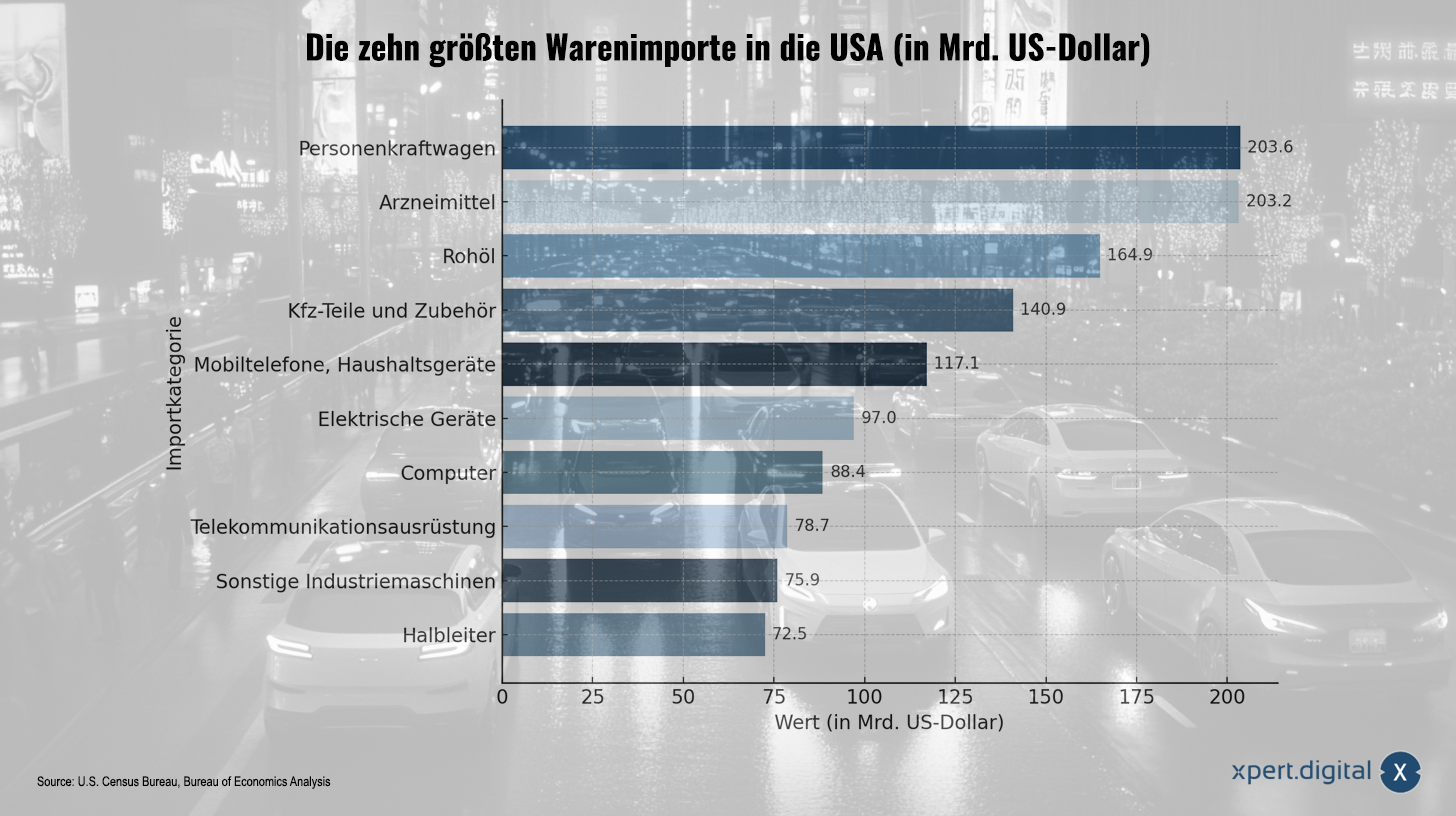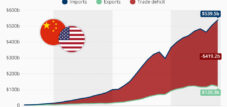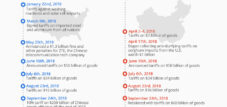The US Trade Deficit: A Challenge for the Global Economy
Language selection 📢
Published on: November 21, 2024 / Update from: November 21, 2024 - Author: Konrad Wolfenstein
🔍📊 Deficit in sight: Trump's trade strategy under scrutiny
🌎💼 The trade balance of the United States of America 📈🔍
The United States have been one of the leading business powers in the world for decades, but the country's trade balance has been a considerable deficit for years. This deficit that arises when the imports of a country exceed exports is a central concern of US economic policy. Under President Donald Trump, who starts a second term with his “America First” agenda, this topic will focus again. Trump plans to reduce the commercial balance sheet deficit by the introduction of new tariffs-often referred to as “Trump-Zölle 2.0”. But why is this so important for him and what effects could these measures have?
The US trade deficit is several hundred billion US dollars annually. Much of this deficit is due to imports from countries such as China, Germany and Mexico. In particular, products such as vehicles, pharmaceuticals, crude oil and electronics account for a significant share of US imports. The ten largest import categories include goods totaling over $1 trillion per year. Passenger vehicles and pharmaceuticals alone account for over $200 billion each, followed by crude oil ($164.9 billion) and automotive parts ($140.9 billion).

Automobile: In the USA, cars continue to be the most important imported goods - Image: Xpert.Digital
Trump sees this deficit as a sign of economic weakness, arguing that it is costing U.S. jobs and increasing dependence on foreign producers. His solution: protectionist measures such as tariffs on imports to strengthen domestic production and reduce import pressure.
✨🔍 Why Trump relies on tariffs
Imposing tariffs is not new for Trump. Already in his first term in office, he implemented punitive tariffs against countries such as China and members of the European Union. His argument is based on several assumptions:
- Protecting domestic industry: Higher import costs are intended to make American companies more competitive.
- Promoting jobs: If less is imported, the demand for domestic products increases, which should create jobs.
- Reducing the trade deficit: Higher tariffs are intended to reduce imports and promote exports.
Trump has said he will impose blanket tariffs of 10% on all imports, as well as specific tariffs of up to 60% on Chinese goods. Sectors such as the automotive industry and electronics would be particularly affected.
📊📦 The meaning of the import categories
A look at the numbers shows that certain import categories could be particularly in focus:
- Passenger Cars ($203.6 billion): The automotive industry has traditionally been a target of protectionist measures. Trump could introduce high tariffs here to hit foreign manufacturers such as German or Japanese brands.
- Pharmaceuticals ($203.2 billion): Reliance on imported drugs could be reduced through tariffs, but this would potentially increase healthcare costs in the US.
- Crude oil ($164.9 billion): While the US has expanded its own oil production, crude oil remains one of the largest import items.
- Electronics ($97 billion) and computers ($88.4 billion): These categories are heavily dependent on Asian markets, particularly China.
These numbers illustrate the challenge: Many of these products are essential to everyday life and the economy of the USA. A drastic increase in prices through tariffs could have a negative impact on consumers and businesses.
🌍🔄 Potential Impact of Trump Tariffs 2.0
The introduction of new tariffs will have noticeable consequences both in the USA and worldwide:
1. Rising prices for consumers
Higher import costs are often passed on to end consumers. Products such as cars or electronics could become significantly more expensive.
2. Burden on companies:
Companies that rely on imported components – such as those in the automotive or electronics industries – could have higher production costs.
3. Trade conflicts
Countries like China or Germany could respond with their own punitive tariffs, which could lead to a trade war.
4. Inflation
Higher prices could fuel inflation in the U.S. and force the central bank to further raise interest rates.
5. Relocation of production facilities
Some companies may move production to the US to avoid tariffs.
💭❓ Criticism of Trump's approach
Although Trump's policies are aimed at reducing the trade deficit, there are significant doubts about their effectiveness:
Economic theory
Many economists argue that the trade deficit is related less to import tariffs than to national savings and investment rates.
Past experiences
During Trump's first term, the trade deficit continued to rise despite tariffs - an indication that these measures may not produce the desired results.
Global supply chains
In a globalized world economy, many products are the result of international collaboration. Tariffs could disrupt these supply chains.
📈🏡 Reduce trade deficit and strengthen the domestic economy
Trump's “America First” policy aims to reduce the commercial balance deficit and strengthen the domestic economy. However, the planned Trump-Zölle 2.0 could have significant side effects-both for the USA and for its trading partners. While some industries may benefit, there are other increasing costs and economic uncertainty.
The figures clearly show that certain import categories such as vehicles or electronics could be particularly affected. Whether Trump's approach will ultimately be successful or whether he will be disappointed again remains to be seen. What is clear, however, is that the coming years will be crucial for the future of global trade and the US's role in it.
📣 Similar topics
- 📊 US trade deficit: A challenge?
- 🚚 Import dependency of the USA: Facts at a glance
- 🇺🇸 Trump's “America First”: Focus on new tariffs
- 🔍 Impact of Trump's trade policy under the microscope
- 🛡️ Protectionism: The US path to economic independence?
- 💰 The USA's top imported goods: Who is affected?
- ⚖️ Trade balance and its global implications
- 📈 Reality of Trump Tariffs: Is the US Better Off?
- 🌍 Global trade conflicts: The potential consequences of Trump tariffs
- 💼 Challenges and Opportunities for the US Economy
#️⃣ Hashtags: #USTrade Policy #TrumpTariffs #Protectionism #ImportDeficit #Economic Strategies
Our recommendation: 🌍 Limitless reach 🔗 Networked 🌐 Multilingual 💪 Strong sales: 💡 Authentic with strategy 🚀 Innovation meets 🧠 Intuition
At a time when a company's digital presence determines its success, the challenge is how to make this presence authentic, individual and far-reaching. Xpert.Digital offers an innovative solution that positions itself as an intersection between an industry hub, a blog and a brand ambassador. It combines the advantages of communication and sales channels in a single platform and enables publication in 18 different languages. The cooperation with partner portals and the possibility of publishing articles on Google News and a press distribution list with around 8,000 journalists and readers maximize the reach and visibility of the content. This represents an essential factor in external sales & marketing (SMarketing).
More about it here:
🌎📈⚖️ The USA and its dependence on imports: challenges and perspectives
📉🛑 Import risks: US economy between dependence and uncertainty
The United States of America is one of the largest economies in the world and at the same time one of the most important players in international trade. In 2023, the US imported goods worth around $3.1 trillion. The leading imported goods include cars, pharmaceuticals and technological products such as smartphones, computers and semiconductors. These goods play a central role in the American economy and the everyday life of the population. But dependence on imports also entails risks, especially in times of geopolitical tensions and economic upheavals.
🚗🚙🛻 Cars as the front runner among imported goods
Cars are at the top of American import statistics. The United States is a huge market for international car manufacturers, including German companies such as Volkswagen, BMW and Mercedes-Benz. These brands enjoy a high reputation in the USA and primarily serve the demand for premium vehicles. At the same time, the US also imports vehicles from countries such as Japan, South Korea and Mexico, which are also major players in the automobile market.
The importance of cars as imported goods is reflected not only in their economic relevance, but also in their political explosiveness. Former President Donald Trump repeatedly discussed tariffs on foreign vehicles during his time in office to protect the domestic automotive industry. “America First” was his motto, aimed at moving production domestically and securing jobs in the United States. But such protectionist measures could have far-reaching consequences – both for American consumers and for international trade relations.
📱💻🔌 Technology imports: backbone of modern society
In addition to cars, technological products such as smartphones, computers and semiconductors are among the most important imported goods in the USA. These goods are essential to modern society and drive innovation in almost all areas of life. However, the US's dependence on technology imports is a weak point, particularly when it comes to semiconductors, which are considered the "heart" of modern electronics. A majority of these chips are produced in Asia, particularly in countries like Taiwan and South Korea.
The COVID-19 pandemic has shown how fragile global supply chains can be. Semiconductor shortages have had a massive impact on various industries, from automotive to consumer electronics. These experiences have sparked discussions in the United States about the need to expand domestic production capacity for critical technologies.
📉💸📊 The trade deficit: A chronic problem
A central point of contention in US international trade is the trade deficit in goods trade. In 2023, this deficit was approximately $1.15 trillion - a clear indication that the US imports significantly more goods than it exports. This imbalance has been a topic of economic policy debates for years and is often described as unfair by politicians like Donald Trump.
Trump has repeatedly argued that trade deals are designed to benefit other countries and put the American economy at a disadvantage. His response was punitive tariffs on imports from Europe and China. For example, he announced tariffs of 10 to 20 percent on European goods and 60 percent on imports from China. While such measures were intended to reduce the trade deficit, they created tensions with key trading partners and threatened to reignite global trade conflicts.
🌍🛡️🌐 The effects of protectionist measures
Protectionist measures such as punitive tariffs have far-reaching consequences – both for the economy and for consumers. Such tariffs could mean significant losses for German car manufacturers such as Volkswagen, BMW and Mercedes-Benz, as the USA is one of their most important sales markets. But not only international companies would be affected: American consumers would also have to expect higher prices.
An example of this is the automotive sector: when tariffs are imposed on imported vehicles, their prices inevitably rise. This could result in many Americans no longer being able to afford new cars or having to switch to cheaper models. At the same time, higher prices for technology products such as smartphones or computers could make access to modern technology more difficult - a setback for innovation and competitiveness.
🇺🇸🤝🇨🇳 The trade war with China: A global challenge
The relationship between the USA and China is particularly tense - two economic powers whose trade relationships are characterized by mutual dependence. China is one of the USA's largest trading partners and at the same time a main supplier of many technical products. Trump's tariffs on Chinese goods were aimed at putting economic pressure on China while strengthening domestic industries.
But this approach also had negative consequences: Chinese countermeasures led to a decline in American exports to China - especially agricultural products such as soybeans and pork. This hit particularly hard on American farmers, who are heavily dependent on the Chinese market.
🏗️📚💡 Long-term perspectives: How can the USA strengthen its position?
To remain competitive in the long term and reduce its dependence on imports, the United States must take strategic actions:
Promoting domestic production
Expanding national production capacities – particularly in key industries such as technology or automobile manufacturing – could help reduce dependencies.
Investments in education and research
Innovation is a crucial factor for economic success. New technologies can be developed through targeted investments in education and research.
Diversification of trading partners
Wider diversification of imports across different countries could minimize the risk posed by geopolitical tensions.
Sustainable trade agreements
Instead of unilateral punitive tariffs, multilateral agreements could help create fair conditions in international trade.
🗺️📦🔍 Challenges in international trade
The United States faces major challenges in international trade. The country's high dependence on imports - especially for cars and technological products - makes it vulnerable to external shocks and geopolitical tensions. Protectionist measures such as punitive tariffs can protect certain industries in the short term, but they carry the risk of long-term damage to the economy and consumers.
A sustainable solution requires a balanced strategy: the promotion of domestic industries must go hand in hand with an open trade policy and international cooperation. This is the only way the USA can maintain its economic strength and at the same time secure its position in global competition.
📣 Similar topics
- 🚗 American car imports: More than just vehicles
- 🌐 Focus on US import dependency
- 📉 Trade Deficit: American Challenge
- 💻 Technological import: strength or weakness?
- ⚙️ Protectionism: A blessing or a curse for the US economy?
- 🎯 Strategies to strengthen the US position in global trade
- 🤝 USA and China: A tense economic coexistence
- 🇺🇸 Challenge: Promote domestic production
- 🔧 Effects of protectionist measures analyzed
- 🔄 The future of American trade relations
#️⃣ Hashtags: #ImportDependency #Trade Deficit #Technology Imports #Protectionism #USAChinaTrade
We are there for you - advice - planning - implementation - project management
☑️ SME support in strategy, consulting, planning and implementation
☑️ Creation or realignment of the digital strategy and digitalization
☑️ Expansion and optimization of international sales processes
☑️ Global & Digital B2B trading platforms
☑️ Pioneer Business Development
I would be happy to serve as your personal advisor.
You can contact me by filling out the contact form below or simply call me on +49 89 89 674 804 (Munich) .
I'm looking forward to our joint project.
Xpert.Digital - Konrad Wolfenstein
Xpert.Digital is a hub for industry with a focus on digitalization, mechanical engineering, logistics/intralogistics and photovoltaics.
With our 360° business development solution, we support well-known companies from new business to after sales.
Market intelligence, smarketing, marketing automation, content development, PR, mail campaigns, personalized social media and lead nurturing are part of our digital tools.
You can find out more at: www.xpert.digital - www.xpert.solar - www.xpert.plus



























